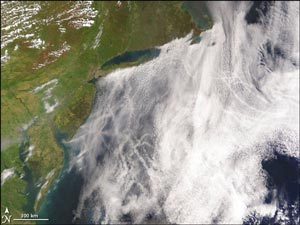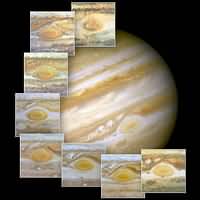Monthly News Summary- June 2005
Reaching Out to Jupiter
|
Evolution of Jupiter’s biggest storm. The Hubble Heritage Team (STScI/AURA/NASA) and Amy Simon (Cornell U.)
|
NASA has selected the $700 million Juno mission to Jupiter as the second in its New Frontiers planetary science program. Juno will study Jupiter in depth from a spacecraft in polar orbit. Scott Bolton, of the Southwest Research Institute in San Antonio, TX, is principal investigator. The Jet Propulsion Laboratory and Lockheed Martin Space Systems will manage and build the spacecraft. Launch is scheduled for 2009 with the spacecraft to orbit Jupiter in 2014. The scope of Juno’s study is very broad. According to a NASA news release, the mission would investigate Jupiter’s core, atmosphere, and magnetosphere.
Rosalyn Pertzborn, director of SSEC’s Office of Space Science Education will lead Juno’s approximately $12 million Education and Public Outreach (EPO) program. Pertzborn said that “Substantial leveraging is achieved through strategic partnerships with two existing programs: the American Association of Physics Teachers (AAPT) Rural Systemic Initiatives, and the Goldstone Apple Valley Radio Telescope (GAVRT) project. Our broad program targets rural America as the primary audience, including regions with substantial Native American and Hispanic populations, and young women in rural and urban areas.”
Pertzborn noted that the Juno EPO program is comprised of “experienced and capable partners in three key areas—formal education, informal education and public outreach. Their program develops a coherent suite of core, quality education products and activities that align with Juno science objectives.” The culminating event of the EPO program uses the Junocam imaging camera. The camera and its accompanying educational program will enable students to interact with Juno scientists to produce and analyze the first images taken from above Jupiter’s poles.
SSEC was last involved in a Jupiter mission in the 1980s and ’90s when SSEC scientist Lawrence Sromovsky led the instrument team that produced the Net Flux Radiometer for the Galileo Mission probe. The first mission in the New Frontiers series is New Horizons, scheduled to fly by Pluto and its moon, Charon, in 2014, and then target other Kuiper belt objects.
Ship Tracks: Contrails, clouds formed from airplane exhaust, are commonly seen in satellite images. Less common are tracks of ships, as seen in this image taken by the MODerate-resolution Imaging Spectroradiometer (MODIS) on NASA’s Terra satellite on May 11. According to the NASA Earth Observatory Web site, these clouds “form around the exhaust released by ships into the still ocean air.” More details are provided on the page. Liam Gumley supplied the image through SSEC’s Direct Broadcast facility. The image was also featured in the emailed column, Earth Observatory: What’s New for the week of 17 May 2005.
 |
MODIS image from 11 May showing tracks from ships, not contrails. |
Wisconsin wildfire: On May 5, a relatively small brush fire near Big Flatts, WI quickly turned into a 4,000-acre forest fire. The fire caused the evacuation of more than 100 people in and around this small town in central Wisconsin and caused extensive property damage. CIMSS’s GOES-12 Wildfire Automated Biomass Burning Algorithm (WF_ABBA) identified the fire at 1:15 p.m. Mirroring the intensity of the fire, the pixel became completely saturated by 1:32 p.m. The rapid intensification of this small brush fire resulted in the area’s biggest wildfire in more than 20 years. Click on the image for an animation.
Launch preparation: Hal Woolf (CIMSS) provided the National Environmental Satellite, Data and Information Service (NESDIS) with spectral transmittances for the High Resolution Infrared Sounder (HIRS), the Advanced Microwave Sounding Unit (AMSU), and the Microwave Humidity Sounder (MHS). This data helped NESDIS as they prepared for the May 20 launch of the NOAA-N satellite.
McMurdo winds: The MODIS polar winds group at CIMSS recently began generating polar winds data from McMurdo Station, Antarctica. MODIS data obtained through the National Science Foundation’s direct broadcast system set up at McMurdo provides the necessary satellite information. After processing in McMurdo, wind data and plots come to CIMSS for analysis. Using McMurdo polar winds data, the polar winds group hopes to reduce the time needed to generate wind information and to provide forecasters in McMurdo with real-time products.
Popular Whyfile: Steve Ackerman (CIMSS) and Tom Whittaker’s (CIMSS) interactive tornado animation continues to attract attention in the UW’s Whyfiles. User Graham Tate recently gave it a rave review. “OH MY GOD! that java tornado is so cool!” he responded via an online feedback form. This module earned Ackerman, Whittaker and the Whyfiles Sue Medaris a Pixie award nomination for the Best Web Design that Incorporates Motion.
Drilling deep: The Spring 2005 Observer, a publication of UW–Madison’s Physical Sciences Laboratory (PSL), reported on the Deep Ice Sheet Coring (DISC) drill, a project of SSEC’s Ice Coring and Drilling Services and PSL. ICDS engineers Alex Shturmakov, Bill Mason and Grant Emmel are working with PSL staff to realize their design, from part drawings to part fabrication, including the drill shaft, the heart of a drill that can core ice 3800 meters deep. The National Science Foundation supports this project which will benefit ice-core studies of climate change, the West Antarctic ice sheet, microbial biology of the ice, and biology and biochemistry. The drill is to be tested in Greenland this summer.
Each year, the National Science Foundation compiles news clips on research they have supported. As is usual, many SSEC researchers’ activities in Antarctica and in the Arctic are noted in the media, and some of them found their way into Polar Press Clips 2004.
The New Zealand Herald covered the Ice Cube project. A graphic representation explained that, to drill the 2.4 km deep holes, drillers “will use a 5 megawatt jet of hot water to melt a hole a bit wider than half a meter.” The hot water drill used to drill such large, deep holes was designed by SSEC’s Ice Coring and Drilling Services(ICDS) and fabricated with the help of UW–Madison’s Physical Sciences Laboratory. Ice Cube is a project within the Antarctic Astronomy and Astrophysics Research Institute, an independent unit within UW–Madison’s Graduate School.
 |
The Enhanced Hot Water Drill is being assembled in Antarctica for use in the IceCube neutrino telescope.More drilling pictures are in the ICDS picture gallery. |
Also, ICDS engineers Robin Bolsey and Bruce Koci are reviewing the concept of a hot water drill to be used in a project led by New Zealand scientist Gary Wilson called Andrill. Covered in the Otago Daily Times (New Zealand), the project will drill through many meters of sea ice, water, and sediment to learn about Antarctica’s ice sheets over time.
NSF supports Arctic as well as Antarctic research. The Study of Environmental Arctic Change, or SEARCH, has begun a multi-agency effort to intensively study environmental change in the north polar regions. Researchers have met to pool their knowledge and discuss strategy, including Jeff Key, team leader of the NOAA/NESDIS Advanced Satellite Products Branch stationed at UW–Madison’s SSEC. Key leads a group at SSEC whose satellite meteorology studies focus on Earth’s polar regions, especially the Arctic.
SSEC researchers, particularly those in the Antarctic Meteorological Research Center, engaged in many more newsworthy projects in 2004. You can find them and more in past In the News columns.
Improving cloud forecasts: Recently, Andrew Heidinger (NOAA/ASPB at CIMSS) upgraded his program, Clouds from AVHRR-extended (CLAR-x) to read forecast fields from the National Centers for Environmental Prediction. It produces estimates of the infrared radiances observed by the Advanced Very High Resolution Radiometer (AVHRR) on the NOAA polar-orbiting satellite. This product will help diagnose strengths and weaknesses of NCEP cloud forecasts.
Orbiting the poles: In mid-May, the team working on the National Polar-orbiting Operational Environmental Satellite System (NPOESS) project met to identify current issues and concerns with the process of developing this system and to foster collaboration among its members. Andrew Heidinger co-chaired a session on cloud remote sensing. At the meeting, project leaders announced that SSEC will head the development and implementation of the evaluation system for the Cloud/Atmospheres product.
Presentations and Publications
Cloud-clearing publication: Jun Li (CIMSS), Chian-Yi Liu (CIMSS), Allen Huang (CIMSS), Xuebao Wu (CIMSS), Tim Schmit (ASPB with SSEC) and Paul Menzel (ORA with SSEC) with James Gurka (OSD) co-authored a paper discussing cloud data for certain measurements obtained using MODIS. Titled “Optimal cloud-clearing for AIRS radiances using MODIS,” the IEEE Transactions on Geoscience and Remote Sensing published this manuscript in their June 2005 issue.
Like Venus: SSEC planetary scientist Sanjay Limaye spoke to the Rotary Club in Edgerton, WI in late March about global warming, giving a decidedly planetary spin to his talk. The Edgerton Reporter on April 6 noted that Limaye compared global change slowly occurring on Earth to that on Venus, where the planet heated so much that over time the atmosphere came to be made entirely of unbreathable carbon dioxide. “Be wise in your energy use,” Limaye was quoted as saying, “lest we turn into Venus.”
Mars by way of Fort Atkinson: During Fort Atkinson’s Wisconsin Alumni Association Founder’s Day Celebration on May 19, Sanjay Limaye gave a presentation titled “Going to Mars.” He discussed the specifics of space exploration. The group’s Web site praised Limaye’s work with SSEC: “Our knowledge of the atmospheric conditions on other planets would be incomplete without the award-winning research and analysis of Sanjay Limaye.”


